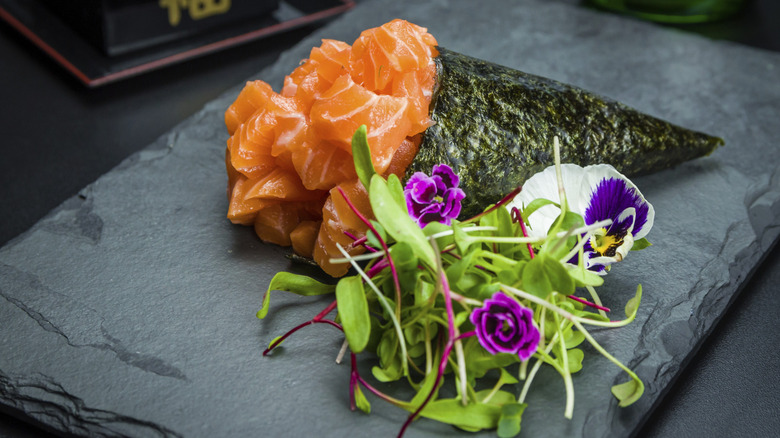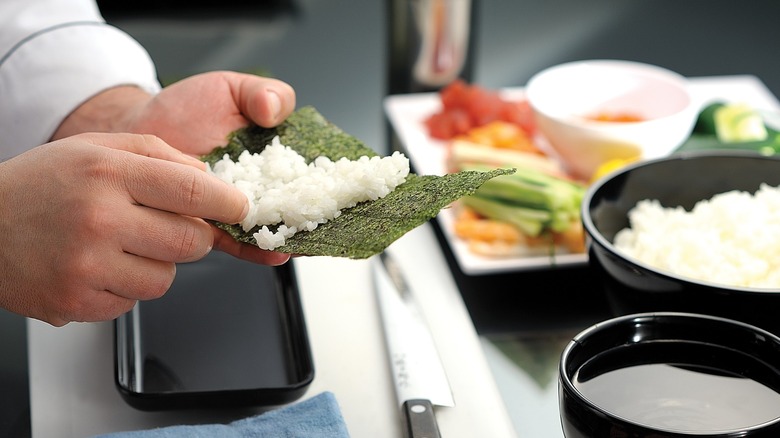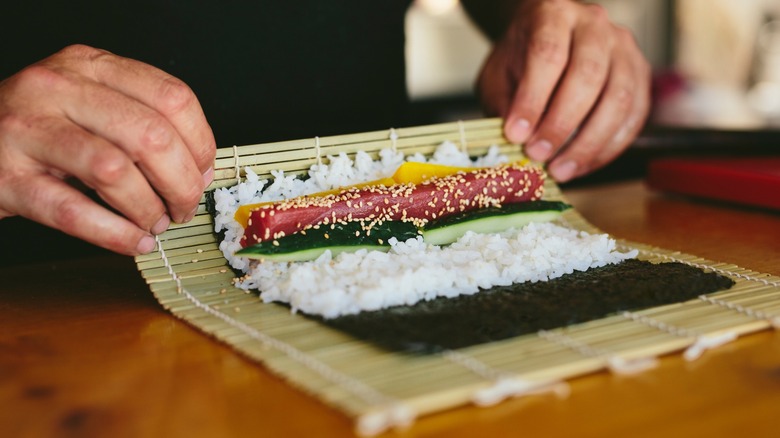Temaki Vs. Maki: Is There A Difference Between The Sushi Rolls?
From bustling cities to small towns, and from the food aisles in major grocery chains like Kroger to local convenience stores, sushi has become nearly as ubiquitous as burgers that you sometimes spot them on the same restaurant menu in the U.S. Ask any American about their favorite Japanese food, and the answer is probably sushi, the quintessential Japanese dish that's taken the country by storm. And it's no surprise why. Sushi comes in endless variations, customizable to fit all tastes and budgets. From all-you-can-eat buffets to Michelin-starred omakase experiences, sushi always offers something new and satisfying, making it hard for anyone to get bored.
Sushi, while seemingly simple with its core ingredients of vinegared rice, various proteins with raw fish being the most common, vegetables, and often with nori (seaweed), actually comes in a wide variety of forms. Two of the most commonly confused types are maki and temaki, particularly due to their similar-sounding names. However, despite the same essential ingredients, they are different: maki is the traditional nori (seaweed) rolled sushi cut into bite-sized pieces, often enjoyed with chopsticks, while temaki is a hand-rolled cone-shaped creation wrapped in nori, meant to be eaten as a whole with your hands, much like an ice cream.
Temaki
In Japanese, "maki" refers to any sushi roll that incorporates nori, while "te" means "hand," making temaki translate to hand-rolled sushi, emphasizing its handheld nature. Temaki originated in the 19th century late Edo period, a time when sushi was rapidly evolving. Street vendors popularized sushi for its convenience, and the cone-shaped temaki emerged as a more portable option, ideal for busy people on the go . Its handheld design made it easy to eat while walking, and it quickly became a favorite among Edo-period residents.
Like nigiri sushi, which features a ball of vinegared rice topped with wasabi and a slice of raw fish or other ingredients, temaki is designed to be handheld. Although not as commonly seen as maki or nigiri sushi, temaki is quickly becoming a hit in sushi restaurants as well as on social media posts, thanks to its visually striking presentation. With ingredients spilling out from the cone-shaped roll, temaki invites you to devour it from top to bottom. Unlike the more reserved, compact nature of maki rolls, temaki feels like a sushi celebration–generously packed with an array of ingredients that offers a more casual, abundant take on smaller maki rolls.
Maki
Whether you opt for a simple salmon roll or a party-ready California roll, maki is one of the most popular types of sushi in the U.S. It consists of bite-sized pieces of rolled sushi, typically prepared with a bamboo mat. Sometimes, the rolls are made inside out, with the nori (seaweed) tucked inside.
Maki sushi, thought to have originated during Japan's Edo period in the late 18th century, before the creation of temaki, quickly gained popularity throughout the country. Traditionally, maki sushi can be classified into three types based on its size from small to large: hosomaki, nakamaki, and futomaki. Each type offers a distinct sushi experience, with hosomaki being the simplest, often highlighting a single vegetable or fish rolled inside. Nakamaki, or chumaki, strikes a balance by incorporating a couple of ingredients, while futomaki takes a more elaborate maximalist approach that packs a wide range of fillings, usually more than three, into a thick roll.
So, temaki or maki–which one wins your heart? Whether you enjoy the handheld, vibrant fun of temaki or the bite-sized precision of maki, both styles offer something unique. Next time you're out for sushi, get both to enjoy the best of both worlds.


